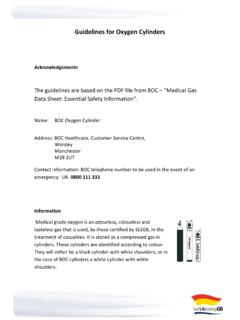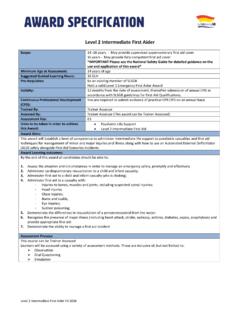Transcription of Guidelines for Oxygen Cylinders - Life Saving …
1 Guidelines for Oxygen Cylinders Acknowledgements The Guidelines are based on the PDF file from BOC Medical Gas data sheet : Essential safety Information . Name: BOC Oxygen cylinder Address: BOC Healthcare, Customer Service Centre, Worsley Manchester M28 2UT. Contact information: BOC telephone number to be used in the event of an emergency: UK 0800 111 333. Information Medical grade Oxygen is an odourless, colourless and tasteless gas that is used, by those certified by SLSGB, in the treatment of casualties. It is stored as a compressed gas in Cylinders . These Cylinders are identified according to colour. They will either be a black cylinder with white shoulders, or in the case of BOC Cylinders a white cylinder with white shoulders. Size Gas Content litres Construction Flow Rates Normal Outlet Pressure bar CD 460 Aluminium Integral regulated 4.
2 (Kevlar hooped ISO 5145 ( Oxygen ). wrapped) 1 15 litres/min Initial safety checks Before handling Cylinders ensure your hands are clean If alcohol based gels or liquids have recently been used ensure it has totally evaporated before Oxygen use. If moisturisers or sun cream have been used ensure hands are dry before Oxygen use. When selecting a cylinder for use ensure it is clean free from any damage, free from oil or grease. Prepare cylinder Ensure you have the correct medical gas and that it is within its' expiry date. (Found on batch label of the cylinder ). Check the cylinder contents gauge on the cylinder valve to ensure that there is Sufficient gas contents in the cylinder Remove the tamper evident seal and cover fitted over the valve outlets Ensure the flow selector is set to zero before using the (black) hand wheel to open the cylinder valve Open the cylinder valve slowly (turn anti clockwise until it stops) and check for any leak.
3 Ensure the outlet (fir tree connector) is free of obstruction. If dirt or other obstruction is seen; briefly turn the flow dial to maximum to clear it Ensure that the correct equipment is selected for connection to the cylinder Connect tubing to the fir tree connector and select appropriate flow rate cylinder leaks Check the connection for leaks using the following procedure: should leaks occur this will usually be evident by a hissing noise close valve, remove connection, check and refit never use excessive force when connecting equipment to Cylinders If leak persists, label cylinder and return to BOC. Use of Cylinders When compressed medical Oxygen Cylinders are in use, ensure that they are: only used for medicinal purposes used only be personnel trained in their use and aware of the potential dangers turned off, when not in use, using only moderate force to close the valve only moved with the appropriate size of handling device handled with care and not knocked violently or allowed to fall firmly secured to a suitable cylinder support when in use not allowed to have any markings, labels or batch labels obscured or removed Do not used in the vicinity of persons smoking or near naked lights.
4 Always check service/expirer dates before use. When administering Oxygen therapy, ensure all details of patient are written in the SLSGB P11 Patient Report Form along with time the Oxygen was administered for. After Use If any contact with salt water has occurred cylinder should be rinsed in fresh water. Do not use any cleaning materials that may contain chlorine or ammonium as they may cause damage to the cylinder package. When the compressed medical Oxygen cylinder is empty ensure that the: cylinder valve is closed using moderate force only and the pressure in the Regulator or tailpipe released Valve outlet cap, where fitted, is replaced Empty Cylinders are immediately returned to the empty cylinder store (dry place/room) for return to BOC Service. Hazards Classification Labelling and Packaging Regulations Danger May cause or intensify fire; oxidiser (H270).
5 Contains gas under pressure; may explode if heated (H280). Keep/Store away from clothing, hydrocarbons and combustible materials. Keep reduction valves free from grease and oil and when possible sand/dust. In case of fire: stop leak if safe to do so. Protect from sunlight: store in a well-ventilated. Dangerous Substances Directive Contact with combustible material may cause fire. Keep out of the reach of children. Keep away from combustible material. Label statements Contact with combustible material my cause fire. No smoking or naked flames near medical Oxygen Cylinders . Use no oil or grease. Keep away from extremes of heat and combustible material. Store Cylinders under cover in a clean, dry and well ventilated area.. Storage of Cylinders Oxygen is a non-flammable gas, but strongly supports combustion.
6 Do not store or use Cylinders near naked flames, sources of ignition or combustible materials. Ensure the Oxygen Cylinders are stored in a safe and secure area where they cannot fall over and cause injury. Commonly this is within a secure cage or chained to the wall. Clearly identify the storage areas with appropriate signage. Ensure separation of full and empty Cylinders . Store medical gas Cylinders separately from industrial and other non medical Cylinders , fuel, oil, grease, alcohol based hand cleaner etc. in a well-ventilated area that is clean and dry, preferably inside. Medical gas Cylinders should not be stored in the same area that is being used to dry equipment Smoking should not be permitted in the vicinity where Cylinders are used or stored. Fire fighting measures If medical Oxygen Cylinders are involved in a fire (size of a paper basket): If it is safe to move the Cylinders , close cylinder valve to stop the flow of product move Cylinders away from source of heat if it is not safe to move the Cylinders , Cool with water from a protected position.
7 All types of fire extinguishers may be used when dealing with a fire involving medical Oxygen Cylinders . If the fire and rescue service attend it is vital they are informed that medical Oxygen Cylinders are inside the building and where they will be located. Accidental release measures If a large volume of medical Oxygen is released, for example if the cylinder is damaged. It may begin moving at high speed in erratic directions. If safe to do so, you should: Close the cylinder valve Where possible, isolate all sources of ignition If release continues, evacuate the area and ensure that the affected area is Adequately ventilated before re-entry. Exposure controls When using medical Oxygen Cylinders ensure adequate ventilation. If clothing does become impregnated with Oxygen (due to leak), keep away from source of ignition or open flames.
8 Clothing impregnated with Oxygen should be advised to ventilate in fresh air for up to 15 minutes. Disposal considerations It is recommended that medical Oxygen Cylinders should not be vented after use; they should be returned to BOC, with any residual gas*, where they will be vented before refilling in a safe environment. *note; this is due to the possible chance of moisture being entrained into the cylinder . Transport of Cylinders When medical Oxygen Cylinders are required to be transported, ensure that the Cylinders are: located in a compartment separated from the driver adequately restrained Check for leaking, and have their valves closed. The vehicle must be adequately ventilated, and the load be secured. Signs should be carried on the outside to inform the public of what is being carried (see above pictures).
9 Ensure the driver is aware of the potential hazards and that detail of this information sheet is carried and understood in the event of any emergency. It is advisable to provide the driver with written instructions that detail the actions to be taken in the event of an accident or emergency. Cylinders should be removed from the vehicle as practicable as possible. Any Oxygen used or kept should be added to the lifeguard unit's CoSHH*. folder. *Control of Substances Hazardous to Health. Use of Cylinders in transit advice to patient/carer If you need to use medical Oxygen within a vehicle, you are advised to: prohibit smoking in the vehicle only carry the minimum number of Cylinders to provide sufficient gas for patient use during the journey/activity ensure all Cylinders are adequately restrained keep cylinder valves closed when not in use avoid using the cylinder when the vehicle is being refuelled set the ventilation system to fresh air or open a window to provide adequate ventilation and to prevent Oxygen enrichment within the vehicle Avoid leaving Cylinders unattended in a vehicle.
10 Unless the vehicle is specifically designed to carry medical Oxygen Cylinders , they should be removed from the vehicle overnight Review Date Review date of document: January 2015. Next date of review: January 2016. Adrian Mayhew National safety Officer Dr P Morgan Medical Advisor Reference 1. Medical Gas data sheet (MGDS), Medical Oxygen (compressed gas);. Essential safety information: 2009 edition. Available at (Accessed August 2012). 2. Take care with Oxygen Fire and explosion hazards in the use of Oxygen . HSE8(rev2). Health and safety Executive (HSE) at (Accessed August 2012). 3. Personal communications with Dr Patrick Morgan: Honorary Medical Advisor for SLSGB. August 2012. 4. Personal Communication with Adrian Mayhew: Water and Event safety Development Officer for SLSGB. 5. SLSGB Lifeguard Manual 2010 edition 6.


